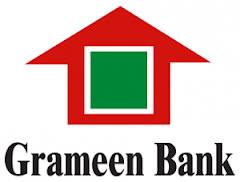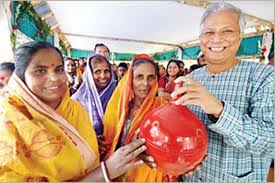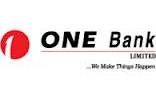Grameen Bank:
The origin of Grameen Bank can be traced back to 1976 when Professor Muhammad Yunus, Head of the Rural Economics Program at the University of Chittagong, launched an action research project to examine the possibility of designing a credit delivery system to provide banking services targeted at the rural poor. The Grameen Bank Project (Grameen means “rural” or “village” in Bangla language) came into operation with the following objectives:
- Ø Extend banking facilities to poor men and women;
- Ø Eliminate the exploitation of the poor by money lenders;
- Ø Create opportunities for self-employment for the vast multitude of unemployed people in rural Bangladesh;
- Ø Bring the disadvantaged, mostly the women from the poorest households, within the fold of an organizational format which they can understand and manage by themselves; and
- Ø Reverse the age-old vicious circle of “low income, low saving & low investment”, into virtuous circle of “low income, injection of credit, investment, more income, more savings, more investment, more income”.
The action research demonstrated its strength in Jobra (a village adjacent to Chittagong University) and some of the neighboring villages during 1976-1979. With the sponsorship of the central bank of the country and support of the nationalized commercial banks, the project was extended to Tangail district (a district north of Dhaka, the capital city of Bangladesh) in 1979. With the success in Tangail, the project was extended to several other districts in the country. In October 1983, the Grameen Bank Project was transformed into an independent bank by government legislation. Today Grameen Bank is owned by the rural poor whom it serves. Borrowers of the Bank own 90% of its shares, while the remaining 10% is owned by the government. Grameen Bank now operates with forty zonal, 264 area and 2,2539 Branch level offices.
A basic principle of Grameen Bank is that the bank goes to the poor people, since it is difficult for the poor people to come to the bank. All banking transactions except loan disbursement have done in the centre meetings at the village level, attended by borrowers and the centre manager who is a bank staff. New branches are required to fund themselves entirely with the deposits they mobilize. No fund from head office or any other office is lent to them. A new branch is expected to break-even within the first year of its operation. There are four interest rates for loans from Grameen Bank : 20% (declining basis) for income generating loans, 8% for housing loans, 5% for student loans (During the studentship that period about 3 – 5 years, the interest rate is 0%), and 0% (interest-free) loans for Struggling Members (beggars). All interests are simple interest, calculated on declining balance method. This means, if a borrower takes an incomegenerating loan of say, BDT 1,000, and pays back the entire amount within a year in weekly installments, she’ll pay a total amount of BDT 1,100, i.e. BDT 1,000 as principal, plus BDT 100 as interest for the year, equivalent to 10% flat rate. Grameen Bank offers very attractive interest rates for deposits. Minimum interest offered is 8.5 per cent. Maximum rate is 12 per cent.
At the end of December 2008, the bank, through its 2,539 branches located in 479 upazilas or sub-districts and all the 64 districts of Bangladesh, was serving 7.67 million members. It had disbursed cumulatively, by the end of December, 2008, BDT 418.90 billion (USD 7.59 billion) as loans. Grameen Bank members also deposit in various savings accounts and the balance of their savings stood at about BDT 34.92 billion. The bank’s services reached 83,566 villages, out of a total of about 84,000 villages in the country.
Grameen bank has declared 30% cash dividend for the year 2008. This is the highest cash dividend declared by any bank in Bangladesh in 2008. Highest record of dividend declared by Grameen Bank was in 2006. It was 100%. The bank has also created a Dividend Equalization Fund to ensure distribution of dividends without much fluctuation in successive years. Receiving of dividends each year greatly inspires our shareholders, 96% of whom are our borrowers.
The Grameen Generalised System:
There was a long period of preparation by the bank staff and management to develop a new flexible loan system that was introduced at the end of 2000. The new system is more simplified and customer friendly that can work equally well both in normal and disaster situations. The Grameen Generalised System offers four types of loan products : 1) the basic loan, 2) the housing loan, 3) the higher education loan, which runs parallel to the basic loan, and 4) the struggling members (beggars) loan programme.
Basic Loan usually has near hundred per cent repayment. A basic loan is converted into a flexible loan or reschedule loan, if the borrower finds it difficult to pay the weekly installment she had promised. Flexible loan allows to reduce her installment size. At the end of 2008, nearly six per cent of the borrowers were on flexible loans. Flexible loan is not an independent loan. It is only a temporary detour from the basic loan. A borrower will always make efforts to go back to the basic loan. If a borrower fails to repay the basic loan and is unwilling to go into flexible loan, she becomes a willing defaulter. 100 per cent provision is made against her outstanding loans. Flexible loan not paid back in two years becomes overdue; 100 per cent provision is made in such a case and after three years, it is written off.
Housing for the poor:
Grameen Bank introduced housing loan in 1984. It became a very attractive programme for the poor borrowers. The ownership of a house infuses people with a sense of confidence, security and self-respect, to begin dreaming for a better life for herself and her family. A member can borrow up to BDT 15,000 for constructing a simple tin-roof house at an interest rate of 8 percent to be paid back over a period of five years. Over 665,568 houses have been constructed with the housing loans averaging BDT 13,103 (USD 191). During 2008, 14,729 houses have been built with housing loans amounting to BDT 152.31 million (USD 2.22 million).
Higher Education Loans:
In 1997, Grameen Bank introduced the Higher Education Loan programme, in an effort to provide new opportunities for talented children of its borrowers to receive higher education. Children of borrowers who enroll in medical schools, engineering, honors and masters degree programmes, agricultural colleges, textile engineering and other higher education programmes, are eligible to receive financing from this loan window. The loans are intended to cover all expenses incurred by students from the beginning of their respective courses until completion, including admission fees, course fees, required stationery, food and accommodation and other related necessary expenses. Until the end of the year 2008, 30,948 students from various disciplines have so far received loans under this programme.
Micro-enterprise Loans:
Many borrowers are moving ahead in business faster than others for many favorable reasons, such as, proximity to the market, presence of experienced male member in the family, etc. Grameen Bank provides larger loans, called micro-enterprise loans, for these fast moving members. There is no restriction on the loan size. So far 1,643,775 members took micro-enterprise loans. A total of BDT 39.41 billion (USD 597.98 million) has been disbursed under this category of loans. Average loan size is BDT 23,978 (USD 348.93), maximum loan size taken so far is BDT 1.60 million (USD 23,283) for truck purchase. The other major items are grocery shop, medicine shop, dairy farm, baby-taxi for transportation and stone business for construction.
Scholarships:
Scholarships are given to the children of Grameen members, with priority on girl children, every year, to encourage them to get better grades in schools. About 23,000 children, at various levels of school education, offered these scholarships in this year. Up to December, 2008 scholarships to the extent of BDT 132.28 million (USD 1.92 million) were offered to 91,700 students.
Loan Insurance:
Under this program, in case of death of a borrower, all outstanding loans are paid off from the insurance fund. Insurance fund is created by the interest generated through a savings account created by an annual deposit of the borrowers. Borrowers are required to put amount equal to 3.0 per cent of the loan amount each time in a designated savings account. If her/his loan amount does not exceed the amount in the previous year, she does not have to add any more money into this account. If it exceeds, then she pays 3.0 per cent of the incremental loan amount. Balance of deposits under loan insurance program stood at BDT 4,262.38 million (USD 62.03 million) as on December 31, 2008. Up to that date 114,851 borrowers died and a total outstanding loans and interest of BDT 831.80 million (USD 12.65 million) left behind was paid off by the bank under this program.
Life Insurance:
Each year families of deceased borrowers of Grameen Bank receive a total of BDT 17 to 20 million (USD 0.25 to 0.29 million) as life insurance benefits. Each family receives BDT 1,500 which the deceased was a Grameen Bank borrower. A total of 110,683 borrowers died so far in Grameen Bank. Their families collectively received a total amount BDT 201.18 million (USD 4.16 million). Borrowers are not required to pay any premium for this life insurance. Borrowers come under this insurance coverage by being a shareholder of the bank.
Village Phones:
To-date Grameen Bank provides loans to 353,909 borrowers to buy mobile phones and offer telecommunication services in nearly half of the villages of Bangladesh where this service never existed before. It is also generating revenue for Grameen Phone, the largest telephone company in the country. Village phones use 2.22 per cent of the air-time of the company, while their number is only 1.64 per cent of the total of telephone subscribers of the company.
Getting Elected in Local Bodies:
Grameen system makes the borrowers familiar with election process. They routinely go through electing group chairman, secretaries, centre-chiefs and deputy centrechiefs every year. They elect board members for running Grameen Bank every three years. This experience has prepared them to run for public offices. They are contesting and getting elected in the local governments. In 2003 local government (Union Porishad) election 7,442 Grameen members contested for the reserve seats for women, 3,059 members got elected.
Policy for Opening New Branches:
New branches are required to finance themselves entirely with the deposits they mobilize. No fund from head office or any other office is lent to them. A new branch is expected to break-even within the first year of its operation.
Crossing the Poverty-Line:
According to an internal survey, 68 per cent of Grameen borrowers’ families of Grameen borrowers have crossed the poverty line. The remaining families are moving towards the poverty line.
Computerized MIS and Accounting System:
Accounting and information management of nearly all the branches (2,537, out of 2,539) have been computerized. This has freed the branch staff to devote more time to the borrowers rather than spend it on paper-work. Branch staffs are provided with pre-printed repayment figures for each weekly meeting. If every borrower pays according to the repayment schedule, the staff has nothing to write on the document except for putting the signature. Only the deviations are recorded. Paper work is done only at centre level to enter figures in the borrowers’ passbooks.
‘Stars’ for Achievements:
Grameen Bank provides colourcoded stars to branches and staffs for 100 per cent achievement of a specific task starting from 2001. A branch or a staff having five-stars indicates the highest level of performance. At the end of 2008, 1,673 branches got green stars for maintaining 100 per cent repayment record, 1,972 received blue star for earning profit, 1,780 branches earned violet stars by meeting all their financing out of their earned income and deposits, 348 branches have applied for brown stars for ensuring education for 100% children of Grameen families and 59 branches applied for red stars indicating branches those have succeeded in taking all its borrowers families over the poverty line. The stars are confirmed only after the verification procedure is completed.
Past five years of Grameen Bank are graphically discussed in the following pages. It includes the cumulative disbursement of loans, disbursement loans of 2008, cumulative disbursement of housing loans, Cumulative Number of Housing Loans, Growth of Membership (Cumulative), Number of Branches (Cumulative), Number of Villages Covered (Cumulative), Number of Full-Time Staff, Trainees & Employees, Number of Offices, Percent of Women Members, Number of Borrowers per Branch (year-end), Total Assets.
Cumulative Disbursement of Loans:
Up to 2004, BDT 2,17314 million was
disbursed as loans. Up to 2008, this figure
reached BDT 418,903 million, which
translates to an increase of 92.76%
during the five-year period.
The average annual growth of cumulative
disbursement of loans during this time
was 18.55%
2008: Disbursement of Loans:
The highest amount of loan disbursed
in the month of November (BDT 6,641 million).
On the other hand, the lowest amount of loan
disbursed in December (BDT 4,580 million).
The average amount of loan disbursed per
month during the twelve months
was BDT 5,175 million.
Cumulative Disbursement of Housing Loans:
Up to 2004, BDT 8,147 million was disbursed as
housing loans. In 2008, this figure stood
at BDT 8,721 million, which translates to an
increase of 7.05% during the five-year period.
The average annual growth of cumulative
disbursement of housing loans during this time was 1.41%.
Cumulative Number of Housing Loans:
Up to 2004, the cumulative number of housing
loans was 607,415. Up to 2008 this figure
reached 665,568. It represents an increase
of 9.57% from 2004 to 2008 and an average
annual growth of 1.91% during the
five-year period.
Growth of Membership (Cumulative)
Up to 2004, the cumulative number of members
was 4.06 million. In 2008, this figure stood at 7.67
million. It represents an increase of 88.94% from
2004 to 2008 and an average annual growth
of 17.79% during the five-year period.
Number of Branches (Cumulative):
Up to 2004, the cumulative number of
branches was 1,358. Up to 2008, this figure
reached 2,539. It represents an increase of 86.97%
from 2004 to 2008 and an average annual growth of
17.39% during the five-year period. Growth of
number of branches in 2008 is 2.34% over the previous year.
Number of Villages Covered (Cumulative):
Up to 2004, the cumulative number of villages
covered was 48,472. In 2008, this figure stood
at 83,566. It represents an increase of 72.40%
from 2004 to 2008 and an average annual
growth of 14.48% during the five-year period.
Concurrently, with the increase in the number
of branches there was a 3.58% increase in the
number of villages covered compared to the
previous year (2007).
Number of Full-Time Staff, Trainees & Employees:
The number of full time staff excluding
Management Trainees was 22,573 in 2008;
while, the number of trainees was 1,667. The number
of employees escalated by a whopping 86 percent within
a short span of 5 Years – from 13,049 in 2004 to 24,240 in
2008. However, the slightly declined by 4% in 2008 due
mainly to rationalisation of manpower and process of
attrition (retirement etc.)
Number of Offices:
In 2008, Grameen Bank had a total of
2,884 offices, including branch offices,
area offices, zonal audit offices, zonal offices
and the head office. Compared to the
previous year, this is a 3% increase in the
number of offices. The number of offices
increased due to the expansion of the
number of branches of Grameen Bank.
Percent of Women Members:
Historically, the majority of members
of Grameen Bank have been women.
The years under consideration are no exception.
The percent of women members throughout
2002 to 2003 was within close proximity of
the 95% mark, from 2004 to 2005 is 96%,
in 2006 to 2007 is 97% and in 2008 it
remain same i.e., 97%.
Number of Borrowers per Branch (year-end):
In 2008, the number of borrowers per
branch (year-end) was 2,460, a 0.89%
decrease compared to the previous year.
In 2007, the number stood at 2,482, a 3.39%
decrease compared to the previous year
Total Assets:
In 2008, the total assets of Grameen Bank
stood at BDT 82.80 billion, a 20% increase
compared to the previous year. In 2007, total assets
increased 16% compared to the previous year.
This upward trend in the assets of Grameen Bank
is the result of healthy loan portfolio growth.
BRAC:
BRAC (Bengali: ব্র্যাক), , based in Bangladesh, is currently (June 2009) the world’s largest non-governmental development organization. Established by Fazle Hasan Abed in 1972 soon after the liberation of Bangladesh, BRAC is currently present in all 64 districts of Bangladesh, with over 7 million micro-finance group members, 37,500 non-formal primary schools and more than 70,000 health volunteers. BRAC is the largest NGO by number of staff employing over 120,000 people, the majority of whom are women. BRAC operates various programs such as those in microfinance and education in over nine countries across Asia and Africa, reaching more than 110 million people. The organization is 80% self-funded through a number of commercial enterprises that include a dairy and food project and a chain of retail handicraft stores called ‘Aarong.’ BRAC maintains offices in 14 countries throughout the world, including BRAC USA and BRAC UK. BRAC is a few years into their initiative to operate in ten African countries in the next ten years.
BRAC tackles poverty from a holistic viewpoint, transitioning individuals from being aid recipients to becoming empowered citizens in control of their own destinies. Over the years, BRAC has organized the isolated poor and learned to understand their needs by piloting, refining and scaling up practical ways to increase their access to resources, support their entrepreneurship and empower them to become active agents of change. Women and girls have been the central analytical lens of BRAC’s anti-poverty approach; BRAC recognizes both their vulnerabilities and thirst for change. BRAC always strives to find practical and scalable approaches to eradicate poverty wherever it is.
In April 2009, Freedom from Want, a book that traces the evolution of BRAC by author Ian Smillie, was published by Kumarian Press
History:
Fazle Hasan Abed, founder of BRAC Known at the time as the Bangladesh Rural Advancement Committee, BRAC was initiated in 1972 by Fazle Hasan Abed at Sulla in the district of Sylhet as a small-scale relief and rehabilitation project to help returning war refugees after the Bangladesh Liberation War of 1971. In nine months, 14 thousand homes were rebuilt as part of the relief effort. Several hundred boats were also built for the fishermen. Medical centres were opened and other essential services were ensured. At the end of 1972, when the first phase of relief work was over, BRAC turned towards long-term development needs and re-organised itself as a multifaceted development organisation focusing on the empowerment of the poor and landless, particularly women and children.
By 1974, BRAC had started providing microcredit and had started analyzing the usefulness of credit inputs in the lives of the poor. Till the mid 70s, BRAC concentrated on community development through multi-sectoral village development programmes that included agriculture, fisheries, cooperatives, rural crafts, adult literacy, health and family planning, vocational training for women and construction of community centres. A Research and Evaluation Division (RED) was set up by BRAC in 1975 to analyze and evaluate its activities and provide direction for the organisation to expand and evolve. In 1977, BRAC shifted from community development towards a more targeted approach by organizing village groups called Village Organizations (VO). This approach targeted the poorest of the poor – the landless, small farmers, artisans, and vulnerable women. Those who own less than half an acre of land and survive by selling manual labor were regarded as BRAC’s target group. That same year BRAC set up a commercial printing press to help finance its activities. The handicraft retail chain called Aarong, was established the following year.
In 1979, BRAC entered the health field in a major way. It established the nation-wide Oral Therapy Extension Programme (OTEP), a campaign to combat diarrhoea, the leading cause of the high child mortality rate in Bangladesh. Over a ten-year period 1,200 BRAC workers went door-to-door to teach 12 million mothers the preparation of home-made oral saline. Bangladesh today has one of the highest rates of usage of oral rehydration, and BRAC’s campaign cut down child and infant mortality from 285 per thousand to 75 per thousand. This initial success in scaling up propelled rapid expansion of other BRAC programmes such as Non Formal Primary Education which BRAC started in 1985 – a model that has been replicated in about a dozen countries.
In 1986 BRAC started its Rural Development Programme that incorporated four major activities – institution building including functional education and training, credit operation, income and employment generation and support service programmes. In 1991 the Women’s Health Development programme commenced. The following year BRAC established a Centre for Development Management (CDM) in Rajendrapur. Its’ Social Development, Human Rights and Legal Services Programme was launched in 1996 with the aim to empower women with legal rights and assist them in becoming involved with community and ward level organizations. In 1998, BRAC’s Dairy and Food project was commissioned. BRAC launched an Information Technology Institute the following year. In 2001, BRAC established a university called BRAC University with the aim to create future leaders and the BRAC Bank was started to cater primarily to small and medium entreprises.
In 2002 BRAC launched a programme called Challenging the Frontiers of Poverty Reduction – Targeting the Ultra Poor (CFPR-TUP) designed specifically for those that BRAC defines as the ultra poor – the extreme poor who cannot access conventional microfinance. The same year BRAC also went into Afghanistan with relief and rehabilitation programmes. It was the first organization in Bangladesh to establish, in 2004, the office of an Ombudsperson.
Objectives of BRAC:
| BRAC has done what few others have – they have achieved success on a massive scale, bringing life-saving health programs to millions of the world’s poorest people. They remind us that even the most intractable health problems are solvable, and inspire us to match their success throughout the developing world. —Bill Gates, Co-chair |
Economic Development:
BRAC’s Economic Development programme includes microcredit, and at present it is prominent among the biggest NGOs in terms of microcredit activities. It provides collateral-free credit using a solidarity lending methodology, as well as obligatory savings schemes through its Village Organisations. Reaching nearly 4 million borrowers, Village Organizations provide different levels of loans to different poverty groups. Through a recent initiative, BRAC has reached out also to those who, due to extreme poverty cannot access microfinance. BRAC defines such people suffering from extreme poverty as the ‘ultra poor’, and has designed a programme customized for this group that combines subsidy with enterprise development training, healthcare, social development and asset transfer, eventually pulling the ultra poor into its mainstream microfinance programme.
Jaminder-Ginni dolls made by village artisans. Handicrafts like these are sold by Aarong, BRAC’s handicrafts store.
In addition to Microfinance, BRAC provides sector-specific enterprise training and support to its member borrowers in poultry and livestock, fisheries, social forestry, agriculture and sericulture. It also provides supply of inputs essential for certain enterprises through its ‘Programme Support Enterprises’ that include Poultry farm and disease diagnostic laboratory, Bull Station, Feed Mill, Broiler Production and Marketing, Seed Production, Processing, Marketing and Soil Testing, BRAC Nursery, and Fish and Prawn Hatchery. BRAC’s Vegetable Export programme started in 1998 is a venture that is aimed at bridging the gap between local producers and international markets. BRAC also has a number of commercial programmes that contribute to the sustainability of BRAC’s development programmes since returns from the commercial programmes are channeled back into BRAC’s development activities. These programmes include Aarong, a retail handicraft chain, BRAC Dairy and Food Project, and BRAC Salt.
Education:
BRAC’s Non-Formal Primary Education programme provides five-year primary education course in four years to poor, rural, disadvantaged children and drop-outs who cannot access formal schooling. These one-room schools are for children between eight and fourteen years of age. Each school typically consists of 33 students and one teacher. Core subjects include Mathematics, Social Studies and English. The schools also offer extracurricular activities. As of June 2008, 37,500 Primary Schools and 24,750 Pre-Primary schools have been established by BRAC enrolling nearly 3 million children, 65% of whom are girls. The schools have a drop-out rate of less than 5%.
BRAC has set up centres for adolescents called Kishori Kendra that provide reading material and serve as a gathering place for adolescents where they are educated about issues sensitive to the Bangladeshi society like reproductive health, early marriage, women’s legal rights etc. BRAC has also set up community libraries 185 out of 964 of which are equipped with computers.
Public health:
BRAC started providing public healthcare in 1972 with an initial focus on curative care through paramedics and a self-financing health insurance scheme. The programme went on to offer integrated health care services, its key achievements including the reduction of child mortality rates through campaign for oral rehydration in the 80s and taking immunization from 2% to 70% in Bangladesh. BRAC currently provides a range of services that reach an estimated 31 million rural poor and include services for mothers in reproductive health care and infants. As of December 2007, 70,000 community health volunteers and 18,000 health workers have been trained and mobilized by BRAC to deliver door-to-door health care services to the rural poor. It has established 37 static health centres and a Limb and Brace Fitting Centre that provides low cost devices and services for the physically disabled. {BRAC At a Glance, June 2006}
In partnership with the government of Bangladesh, BRAC is implementing a Directly Observed Treatment Short-course (DOTS) strategy to treat Tuberculosis in Bangladesh. Its other major partnership programmes with the government and/or other organizations include programmes in malaria prevention and control and arsenic mitigation. BRAC’s Water, Sanitation and Hygiene (WASH) programme, among BRAC’s new initiatives, plans to achieve the target set forth by the government of Bangladesh to achieve the Millennium Development Goal of improved hygienic practices and supply of safe water by the year 2014. Also one of BRAC’s new initiatives is its HIV/AIDS programme addresses awareness raising activities among the generation population including education of couples, adolescent boys and girls, high-risk groups and promotes use of condoms. BRAC also provides treatment for STI/RTI and consumption loans to brothel-based sex workers to empower them for compliance to condom use.
Social Development:
In 1996, BRAC started a programme in collaboration with the Ain O Shalish Kendra (ASK) and Bangladesh National Women Leader’s Association (BNWLA) to empower women to protect themselves from social discrimination and exploitation of which dowry, rape, acid throwing, polygamy, domestic violence and oral divorce are common in rural Bangladeshi communities and to encourage and assist them to take action when their rights are infringed. The programme has two components: the Social Development component and the Human Rights and Legal Services component.
The Social Development component, focuses on building human and socio-political assets of the poor – especially women – through institution building, awareness raising, training and collective social mobilization. As part of this initiative, BRAC has initiated ward-level people’s organizations called the Polli Shomaj (Rural Society) and Union Shomaj (Union Society) which poor rural women members can use as a platform to raise their voices.
The Human Rights and Legal Services component seeks to empower the poor by increasing their awareness of their rights (legal, human and social) and entitlements through participation in activities like the Popular Theatre and through Human Rights and Legal Education (HRLE) classes arranged by BRAC for its Village Organisation members. BRAC also offers external services such as access to lawyers or the police either through legal aid clinics, by helping women report cases at the local police station or when seeking medical care in the case of acid victims. At the end of June 2006, 124,748 HRLE classes were held and 1,332 acid victim cases and 1,735 rape victim cases were reported. {BRAC At a Glance, June 2006}
Disaster Relief:
BRAC conducted one of the largest NGO responses to Cyclone Sidr which hit vast areas of the south-western coast in Bangladesh in mid-November 2007. BRAC distributed emergency relief materials, including food and clothing, to over 900,000 survivors, provided medical care to over 60,000 victims and secured safe supplies of drinking water. BRAC is now focusing on long-term rehabilitation, which will include agriculture support, infrastructure reconstruction and livelihood regeneration.
BRAC Abroad
Afghanistan:
BRAC registered in Afghanistan in 2002 and covers 23 out of 34 provinces. Its major programmes in Afghanistan include Microfinance (funding from MISFA), Health, Education, National Solidarity and Capacity Development. Its Microfinance Program currently has 429 branch offices that have disbursed more than USD 96 million to over 179,000 member households (895,000 people). BRAC now runs nearly 2,371 schools which have seen 118,416 students graduate, almost all of whom are girls. BRAC Afghanistan has 3,617 community health workers and 1,390 poultry and livestock extension workers. It has also established two Training and Resource Centres in Kabul and Mazar-e-Sharif. BRAC’s staff in Afghanistan includes 3,463 locals and 180 expatriates. {Annual Report, 2007}
Sri Lanka:
BRAC registered in Sri Lanka in 2005 following the devastating Tsunami and initiated relief and rehabilitation activities. Its rehabilitation and livelihood programmes in Sri Lanka covers three districts and 43 divisions. BRAC’s work in Sri Lanka so far includes the fisheries, agriculture, poultry and livestock, small business, income-generation activities, education and health sectors. It currently employs 312 staff. {BRAC At a Glance, December 2007}
Pakistan:
BRAC expanded into Pakistan in 2007 and now covers six districts. BRAC Pakistan currently employs 337 staff members that work in 35 offices that are set up in various locations throughout the country. The Microfinance Program supports 837 village organizations that have over 14,544 members. To date, BRAC Pakistan has disbursed over $1,350,000 {BRAC at a Glance, December 2007}
Tanzania:
BRAC Tanzania, established in 2006, has created over 2,700 microfinance village organizations with over 80,000 members and already disbursed more than $17 million. Over 480 community health promoters, 380 agriculture program volunteers and 436 poultry and livestock volunteers have been trained. {Annual Report, 2007} It is a field partner of Kiva Microfunds.
Uganda:
BRAC Uganda’s Microfinance Program has formed over 2,145 village organizations with 59,844 members. To date, the program has cumulatively disbursed $14.8 million with a repayment rate of 100%. BRAC Uganda has also trained 200 community health promoters and opened 122 learning centers in Internally Displaced People (IDP) camps that have enrolled nearly 20,704 learners. {Annual Report, 2007} It is a field partner of Kiva Microfunds.
Southern Sudan:
In 2007, BRAC started operations in Southern Sudan. The microfinance program, which consists primarily of returning war refugees, has already formed 220 village organizations with over 8,400 members. The cumulative disbursement in 2008 was $1,313,150. BRAC Southern Sudan has also initiated a community-based health program under which community health organizers and health promoters receive training. {Annual Report, 2007} It is a field partner of Kiva Microfunds.
West Africa:
BRAC is planning to expand its programs into Liberia and Sierra Leone by the end of 2008. {Annual Report, 2007}
Projects
Partnership with the Nike Foundation:
BRAC is collaborating with Nike’s Girl Effect campaign to launch a new program to reach out to teenagers in Uganda and Tanzania. The Employment and Livelihood for Adolescents program has been successful in Bangladesh and BRAC is now adapting and piloting this program in Africa.[8]
Countries Where BRAC Operates:
- Asia: Bangladesh, Afghanistan, Sri Lanka, Pakistan
- Africa: Uganda, Tanzania, Southern Sudan, Liberia, Sierra Leone
- BRAC has Technical Advisors in Haiti, India, and Indonesia
- BRAC has affiliate organizations in the United Kingdom and U.S.
Awards
BRAC Awards:
- The Conrad N. Hilton Humanitarian Prize, 2008
- Independence Award (Shadhinata Puroshkar), 2007
- Gates Award for Global Health, 2004 Bill and Melinda Gates Foundation
- CGAP Financial Transparency Award, 2005 & 2006
Fazle Hasan Abed’s Awards:
- The Ramon Magsaysay Award for Community Leadership, 1980.
- The Alan Shawn Feinstein World Hunger Award, 1990
- The Maurice Pate Award by UNICEF, 1992
- The Olof Palme Prize, 2001
- The Social Entrepreneurship Award by the Schwab Foundation, 2002
- The International Activist Award by the Gleitsman Foundation, 2003
- The United Nations Development Programme Mahbub ul Haq Award, 2004
- The Henry R. Kravis Prize in Leadership, 2007
- The inaugural Clinton Global Citizen Award, 2007
- The David Rockefeller Bridging Leadership Award, 2008


















